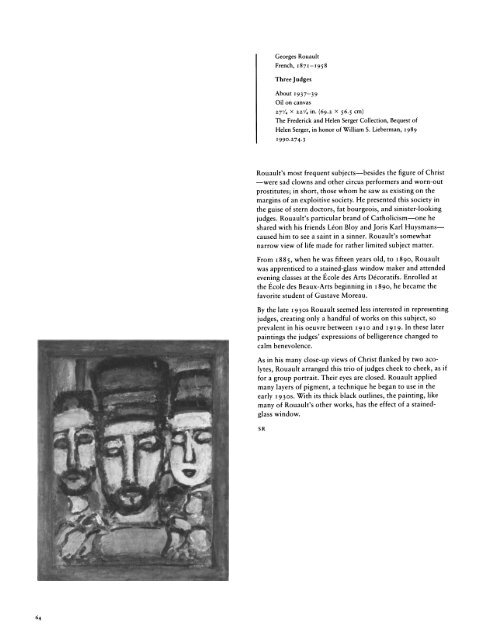The Metropolitan Museum of Art / Bulletin
The Metropolitan Museum of Art / Bulletin
The Metropolitan Museum of Art / Bulletin
You also want an ePaper? Increase the reach of your titles
YUMPU automatically turns print PDFs into web optimized ePapers that Google loves.
Georges Rouault<br />
French, 1871-1958<br />
Three Judges<br />
About I937-39<br />
Oil on canvas<br />
71/4 x zz22/4 in. (69.2 x 56.5 cm)<br />
<strong>The</strong> Frederick and Helen Serger Collection, Bequest <strong>of</strong><br />
Helen Serger, in honor <strong>of</strong> William S. Lieberman, i989<br />
1990.274.3<br />
Rouault's most frequent subjects-besides the figure <strong>of</strong> Christ<br />
-were sad clowns and other circus performers and worn-out<br />
prostitutes; in short, those whom he saw as existing on the<br />
margins <strong>of</strong> an exploitive society. He presented this society in<br />
the guise <strong>of</strong> stern doctors, fat bourgeois, and sinister-looking<br />
judges. Rouault's particular brand <strong>of</strong> Catholicism-one he<br />
shared with his friends Leon Bloy and Joris Karl Huysmanscaused<br />
him to see a saint in a sinner. Rouault's somewhat<br />
narrow view <strong>of</strong> life made for rather limited subject matter.<br />
From i885, when he was fifteen years old, to I890, Rouault<br />
was apprenticed to a stained-glass window maker and attended<br />
evening classes at the Ecole des <strong>Art</strong>s Decoratifs. Enrolled at<br />
the Ecole des Beaux-<strong>Art</strong>s beginning in i890, he became the<br />
favorite student <strong>of</strong> Gustave Moreau.<br />
By the late 1930S Rouault seemed less interested in representing<br />
judges, creating only a handful <strong>of</strong> works on this subject, so<br />
prevalent in his oeuvre between 1910 and I919. In these later<br />
paintings the judges' expressions <strong>of</strong> belligerence changed to<br />
calm benevolence.<br />
As in his many close-up views <strong>of</strong> Christ flanked by two acolytes,<br />
Rouault arranged this trio <strong>of</strong> judges cheek to cheek, as if<br />
for a group portrait. <strong>The</strong>ir eyes are closed. Rouault applied<br />
many layers <strong>of</strong> pigment, a technique he began to use in the<br />
early 1930S. With its thick black outlines, the painting, like<br />
many <strong>of</strong> Rouault's other works, has the effect <strong>of</strong> a stainedglass<br />
window.<br />
SR<br />
64

















